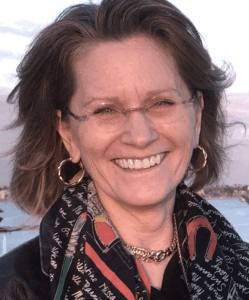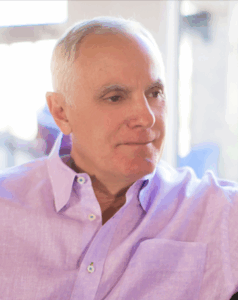Anthony A. Delmedico, PhD, LMFT, is an alumni of Pacifica’s Ph.D. Depth Psychology with an Emphasis in Psychotherapy program. Elizabeth Èowyn Nelson, PhD, is a core faculty member in the Ph.D. in Depth Psychology with Specialization in Integrative Therapy and Healing Practices program. I’m delighted to be speaking with them today about their new book, The Art of Jungian Couples Therapy. To learn more about the Ph.D. in Depth Psychology with Specialization in Integrative Therapy and Healing Practices program, visit us here.
Angela Wood: You’ve described the process of working with couples as being a challenge for analysts and therapists, placing “tremendous demands on their knowledge, their skill, and their own complicated feelings about the mysteries of relationship.” What inspired you to tackle this topic?
Elizabeth Èowyn Nelson: I got very interested in intimate relationships when I wrote my dissertation on the myth of Eros and Psyche, and then published Psyche’s Knife: Archetypal explorations of love and power. I began lecturing on the idea of shadow vows, which is what we don’t say when we say, “I do,” in 2013. Tony heard one of my lectures, and said, “Where’s the book, Elizabeth?” I knew I needed to write that book, so I said, “Let’s write it together.”
Anthony Delmedico: In talking about the intensity of couples therapy, Tavistock’s James Fisher said it is as if therapists awaken to “find themselves in someone else’s nightmare.” As a practicing clinician, I wanted a resource that more spoke more fully to the actual energies encountered when working in the trenches with couples. The breadth of Jung’s analytic psychology speaks to those depths.
Also, my doctoral work at Pacifica explored some of those energies as they applied to men who struggled in divorce, and my research dovetailed with Elizabeth’s work on the shadow vows. In 2023, we wrote an article introducing shadow vows into the academy. In the months that followed, the material remained alive and inspired us to create this work applying Jung’s major contributions to psychology to working with couples.
Elizabeth: When we started reviewing the literature we were surprised to find there is no book that introduces core Jungian ideas and applies them to couples therapy. When I speak with clinicians, they tell me the one issue that brings people into individual or couples therapy is the heartache of love, love’s wounds.
Angela: Is the book intended to be read by therapists or anyone who is interested?
Tony: As an introduction to Jung’s work as it applies to couples, any student or therapist, regardless of their background, training, or level of experience, should find this book helpful in expanding their knowledge base and skill set in their clinical work. This is also a great resource for any couple or individual interested in exploring the depths of their relational experiences.
Elizabeth: We imagined that the book would be read by individuals and couples, too, not just therapists, anyone who wanted to understand aspects of their relationship. It’s my hope if the clinician really likes the book they will recommend it to their clients.
Angela: The idea of the therapist waking into the couple’s nightmare is compelling. Of course, therapists field all kinds of heavy and potentially traumatic things in the counseling room, but to be caught in the middle of the violent emotions that often arise during two people fighting must be quite difficult, especially if you’re an empath. How do you handle that?
Tony: That’s why we wrote the book! We talked a lot about surviving the experience and helping the therapist and couple recognize and name those powerful and often overwhelming things. In our book, we go back to Jung’s quaternity diagram, which more fully accounts for the totality of the two psyches in the room. When you add a third person the psychological field gets really complicated. In our book, we honor and speak to that complexity in ways that are rarely considered in other modalities.
Elizabeth: Slowing down what’s happening in the room is a good strategy, if possible. To invite reflection.
Angela: How do you work with the idea of shadow vows as therapists?
Elizabeth: I’m not a psychotherapist, but when I lecture on shadow vows, I invite the audience to reflect on their own relationships. To bring it home I’ll say, “Let’s take a look at what you declared in this promise, what’s there consciously and what isn’t.” Suppose the person vowed to love, honor, and cherish their partner. I point out that, yes, they promised to love their partner, but there are times when they don’t like them much. They feel aggravated or irritated with them, have even lost respect for them. Or someone may have vowed to cherish their partner, but what they feel in the moment is “He or she is making me crazy and I want to run away.”
Tony: Jung’s writing on alchemy provides a lovely way of thinking about relationships. We climb into an alchemical bath and cook together over time. We all go into the bath with the best of intentions, but over time our shadowed material in the unconscious eventually come to the forefront. How else can we account for two “adults” screaming at each other about the right way to load a dishwasher. These types of fights are everyday expressions of shadow vows , and the work is to help couples acknowledge and work through them.
Sam Keen has this lovely image of a couple exchanging conscious vows in church, and in the basement underneath the altar, the unconscious of each partner is also exchanging vows. Those unconscious vows are often the unacknowledged opposites of those conscious ones. Living together day in and day out eventually puts enough pressure on the fault lines of relationships to bring couples to the place where they can say, “I love you, but I hate you sometimes.” Again, normalizing that for the couple and the therapist is what we’re trying to do.
Elizabeth: There’s a somatic release when you speak the truth. There’s an exhale. It’s palpable. Sometimes it even shifts the resentful or anxious energy in the room into smiles or laughter.
Part II of “The Art of Jungian Couple Therapy” can be read here.
The Ph.D. in Depth Psychology with Specialization in Integrative Therapy and Healing Practices program is now accepting applications. Learn more here.

Dr. Elizabeth Éowyn Nelson teaches courses in research design, process, methodology, and dissertation development as well as dream, archetypal psychology, and technology at Pacifica Graduate Institute. Her books include Psyche’s Knife: Archetypal Explorations of Love and Power (Chiron, 2012) and The Art of Inquiry: A Depth Psychological Perspective (Spring Publications, 2017), coauthored with Joseph Coppin. She is currently writing a new book, co-authored with Anthony Delmedico, The Art of Jungian Couple Therapy (Routledge, 2025). Dr. Nelson teaches and speaks internationally and has published numerous scholarly papers and book chapters on subjects including animals, dreams, feminism, film, mythology, research, somatics, and technology. She has been a professional writer and editor for 40 years, coaching aspiring authors across multiple genres.

Anthony Delmedico has a Ph.D. in depth psychology and an M.A. in counseling psychology from Pacifica Graduate Institute. He has written about the fatherhood and divorce, and is the author of Tending the Wound of Sexual Abuse: An Introduction. He is the founder of First Haven, a 501(c)(3) non-profit organization dedicated to providing psychological self-help information to people ages 15 and up who have experienced sexual abuse. Anthony is a licensed marriage and family therapist and an AAMFT-approved supervisor in private practice in Raleigh, North Carolina. Email: Tony@TonyDelmedico.com.

Angela Wood is a writer for Pacifica Graduate Institute, as well as the editor of the Santa Barbara Literary Journal. Her work has been published in Food & Home, Peregrine, Hurricanes & Swan Songs, Delirium Corridor, Still Arts Quarterly, Danse Macabre, and is forthcoming in The Tertiary Lodger and Running Wild Anthology of Stories, Vol. 5.


